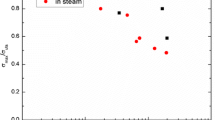Abstract
In this paper, the effect of multiple matrix cracking modes on cyclic loading/unloading hysteresis loops of 2D woven ceramic-matrix composites (CMCs) has been investigated. The interface slip between fibers and the matrix existed in matrix cracking mode 3 and mode 5, in which matrix cracking and interface debonding occurred in longitudinal yarns, are considered as the major reason for hysteresis loops of 2D woven CMCs. The effects of fiber volume content, peak stress, matrix crack spacing, interface properties, matrix cracking mode proportion and interface wear on interface slip and hysteresis loops have been analyzed. The cyclic loading/unloading hysteresis loops of 2D woven SiC/SiC composite corresponding to different peak stresses have been predicted using the present analysis. It was found that the damage parameter, i.e., the proportion of matrix cracking mode 3 in the entire cracking modes of the composite, increases with increasing peak stress.



















Similar content being viewed by others
References
Naslain, R.: Design, preparation and properties of non-oxide CMCs for application in engines and nuclear reactors: an overview. Compos. Sci. Technol. 64, 155–170 (2004). doi:10.1016/S0266-3538(03)00230-6
Bednarcyk, B.A., Mital, S.K., Pineda, E.J., Arnold, S.M.: Multiscale modeling of ceramic matrix composites. 56th AIAA/ASCE/AHS/ASC Struct. Struct. Dynam. Mat. Conf. 5–9 January 2015, Kissimmee, Florida
Gowayed, Y., Ojard, G., Santhosh, U., Jefferso, G.: Modeling of crack density in ceramic matrix composites. J. Compos. Mater. 49, 2285–94 (2015). doi:10.1177/0021998314545188
Reynaud, P.: Cyclic fatigue of ceramic-matrix composites at ambient and elevated temperatures. Compos. Sci. Technol. 56, 809–814 (1996). doi:10.1016/0266-3538(96)00025-5
Fantozzi, G., Reynaud, P.: Mechanical hysteresis in ceramic matrix composites. Mater. Sci. Eng. A Struct. 521–522, 18–23 (2009). doi:10.1016/jmsea.2008.09.128
Kotil, T., Holmes, J.W., Comninou, M.: Origin of hysteresis observed during fatigue of ceramic matrix composites. J. Am. Ceram. Soc. 73, 1879–1883 (1990). doi:10.1111/j.1151-2916.1990.tb05239.x
Pryce, A.W., Smith, P.A.: Matrix cracking in unidirectional ceramic matrix composites under quasi-static and cyclic loading. Acta Metall. Mater. 41, 1269–1281 (1993). doi:10.1016/0956-7151(93)90178-U
Ahn, B.K., Curtin, W.A.: Strain and hysteresis by stochastic matrix cracking in ceramic matrix composites. J. Mech. Phys. Solids 45, 177–209 (1997). doi:10.1016/S0022-5096(96)00081-6
Solti, J.P., Mall, S., Robertson, D.D.: Modeling damage in unidirectional ceramic-matrix composites. Compos. Sci. Technol. 54, 55–66 (1995). doi:10.1016/0266-3538(95)00041-0
Vagaggini, E., Domergue, J.M., Evans, A.G.: Relationships between hysteresis measurements and the constituent properties of ceramic matrix composites: I, theory. J. Am. Ceram. Soc. 78, 2709–2720 (1995). doi:10.1111/j.1151-2916.1995.tb08046.x
Hutchison, J.W., Jensen, H.M.: Models of fiber debonding and pullout in brittle composites with friction. Mech. Mater. 9, 139–163 (1990). doi:10.1016/0167-6636(90)90037-G
Cho, C.D., Holmes, J.W., Barber, J.R.: Estimation of interfacial shear in ceramic composites from frictional heating measurements. J. Am. Ceram. Soc. 74, 2802–808 (1991). doi:10.1111/j.1151-2916.1991.tb06846.x
Li, L.B., Song, Y.D., Sun, Z.G.: Influence of interface de-bonding on the fatigue hysteresis loops of ceramic matrix composites. Chin. J. Solid Mech. 30, 8–14 (2009)
Li, L.B., Song, Y.D., Sun, Z.G.: Effect of fiber Poisson contraction on fatigue hysteresis loops of ceramic matrix composites. J. Nanjing Uni. Aero. Astron. 41, 181–6 (2009)
Li, L.B., Song, Y.D.: Influnece of fiber failure on fatigue hysteresis loops of ceramic matrix composites. J. Reinf. Plast. Compos. 30, 12–25 (2011). doi:10.1177/0731684410386273
Li, L.B.: Modeling the effect of interface wear on fatigue hysteresis behavior of carbon fiber-reinforced ceramic-matrix composites. Appl. Compos. Mater. Online (2015). doi:10.1007/s10443-015-9442-7
Li, L.B., Song, Y.D., Sun, Y.C.: Estimate interface shear stress of unidirectional C/SiC ceramic matrix composites from hysteresis loops. Appl. Compos. Mater. 20, 693–707 (2013). doi:10.1007/s10443-012-9297-0
Kuo, W.S., Chou, T.W.: Multiple cracking of unidirectional and cross-ply ceramic matrix composites. J. Am. Ceram. Soc. 78, 745–755 (1995). doi:10.1111/j.1151-2916.1995.tb08242.x
Lamon, J.: A micromechanics-based approach to the mechanical behavior of brittle-matrix composites. Compos. Sci. Technol. 61, 2259–2272 (2001). doi:10.1016/S0266-3538(01)00120-8
Li, P., Wang, B., Zhen, W.Q., Jiao, G.Q.: Tensile loading/unloading stress–strain behavior of 2D-SiC/SiC composites. Acta Mater. Compos. Sin. 31, 676–68 (2014). doi:10.13801/j.cnki.fhclxb.2014.03.020
Acknowledgments
The author thanks the Science and Technology Department of Jiangsu Province for the funding that made this research study possible
Author information
Authors and Affiliations
Corresponding author
Ethics declarations
Funding
This study has received the support from the Science and Technology Department of Jiangsu Province through the Natural Science Foundation of Jiangsu Province (Grant No. BK20140813), and the Fundamental Research Funds for the Central Universities (Grant No. NS2016070).
Conflict of Interest
The author declares that he has no conflict of interest.
Rights and permissions
About this article
Cite this article
Longbiao, L. Modeling the Effect of Multiple Matrix Cracking Modes on Cyclic Hysteresis Loops of 2D Woven Ceramic-Matrix Composites. Appl Compos Mater 23, 555–581 (2016). https://doi.org/10.1007/s10443-016-9474-7
Received:
Accepted:
Published:
Issue Date:
DOI: https://doi.org/10.1007/s10443-016-9474-7




